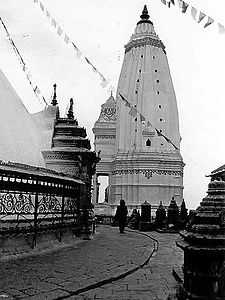
Plans of the main types of buildings with rathas
In Hindu temple architecture, a ratha is a facet or vertical offset projection on the tower (generally a sikhara).[1]
In Sanskrit, the word "ratha" means "chariot", but the link with this meaning is not clear.
The rathas are workshiped and decorated with geometric figures or statues. Such as statues of a gatekeeper watching outside or a niche with a statue of a deity.
Sometimes, the facet of the ratha is hollowed to the interior : these are rathas with recesses.
If there is only one facet, this is a temple with three rathas (triratha): the wall and the facet on the left and on the right.
If there are a main facet and a secondary one, the temple has five rathas (pancharatha). There are also temples with seven rathas (saptaratha).[2][3] and nine rathas (navaratha).
Examples of triratha temples
Examples of pancharatha temples
| Pancharatha temples |
|---|
| Isanesvara Siva Temple in Bhubaneswar |
| Jagannath Temple in Baripada |
| Lingaraja Temple in Bhubaneswar |
|
Main article:
Pancharatha Examples of saptaratha temples
- Chaturbhuja Temple in Khajuraho
- Shiva Lakhesvara Temple near Bhubaneswar
- Sikhara of the temple of Swayambhunath in Katmandou
Examples of navaratha temples
Notes
- ↑ http://tourism.oriyaonline.com/temple_architecture.html
- ↑ http://www.banglapedia.org/httpdocs/HT/A_0291.HTM
- ↑ http://spiritualvedicnames.com/saptaratha/
See also
- Ratha, for the original meaning of the word
External links








